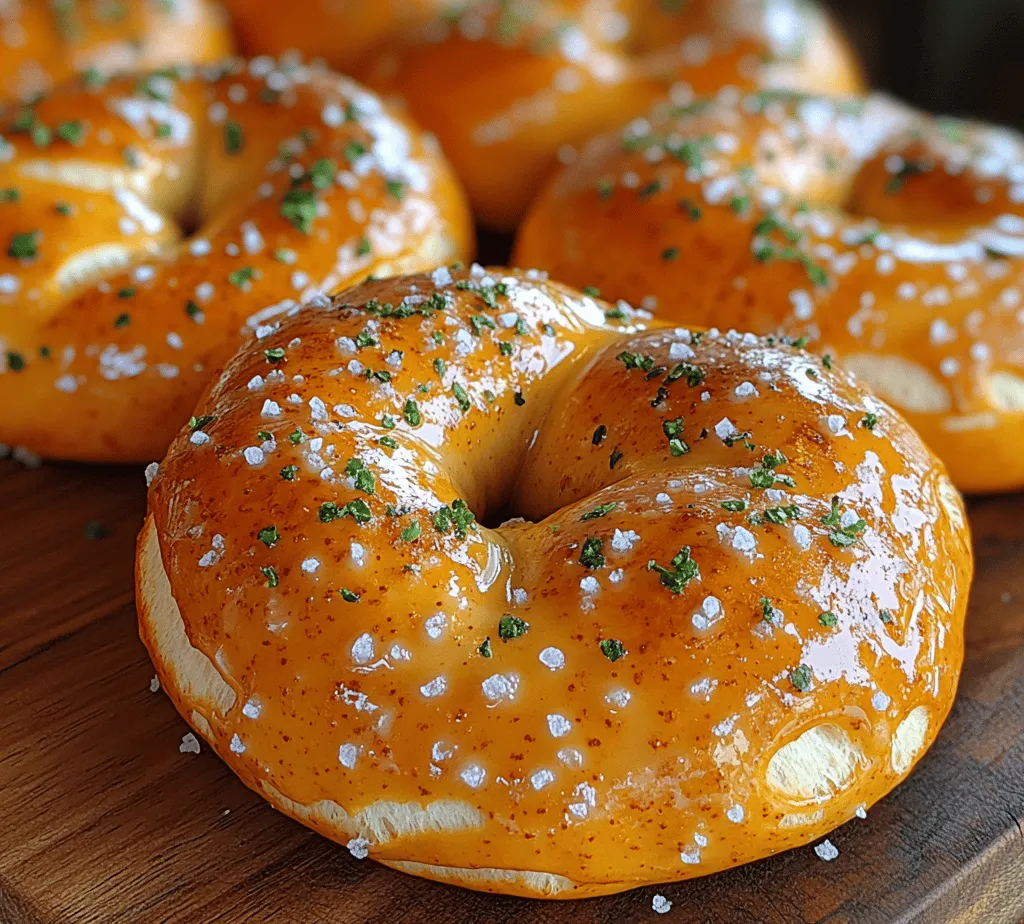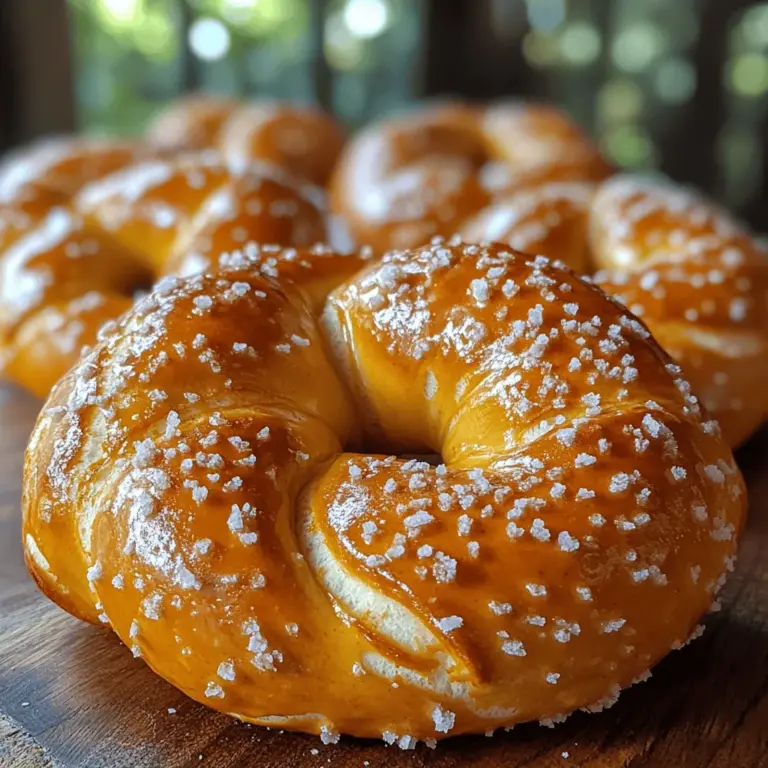Introduction
Soft pretzels have long been a beloved snack, celebrated for their warm, chewy texture and delightful flavor. Whether enjoyed at a bustling street fair, a sporting event, or in the comfort of your own home, there’s something undeniably comforting about indulging in these golden-brown treats. While many people may be familiar with purchasing soft pretzels from their local vendors or favorite snack stands, the allure of homemade pretzels beckons with the promise of freshness, customization, and the joy of baking.
This article introduces you to the delightful world of “Soft & Chewy Pretzel Bliss,” a recipe that aims to replicate the soft, warm, and buttery pretzels you might find at a traditional pretzel shop. As we walk you through each step of the process, you will discover that making soft pretzels at home is not only achievable but also incredibly rewarding.
Our goal is to provide you with a comprehensive, step-by-step guide to crafting perfect soft pretzels in your own kitchen. We’ll cover everything from the historical significance of pretzels to the essential ingredients needed for that ideal texture and taste. So, roll up your sleeves, and let’s embark on this mouthwatering journey together!
Understanding Soft Pretzels
To truly appreciate the magic of soft pretzels, it’s essential to understand their history and cultural significance. The origins of pretzels can be traced back to ancient times, with roots in various European countries. The exact origin is often debated, but one popular theory suggests that pretzels were first created by monks in the early Middle Ages as a reward for children who learned their prayers. The twists of the pretzel are said to represent arms crossed in prayer.
The cultural significance of pretzels extends beyond their intriguing history. In many cultures, pretzels symbolize good luck and prosperity. In Germany, for example, they are traditionally served at weddings and festivals, while in the United States, soft pretzels have become a staple at fairs, sporting events, and street corners, often served with mustard or cheese sauce.
When it comes to pretzels, there are two primary types: soft and hard. Hard pretzels are crunchy snacks that can be enjoyed straight from the bag, while soft pretzels are characterized by their moist, fluffy interiors and chewy exteriors. The primary difference lies in the preparation methods, particularly in how the dough is boiled before baking. This boiling process is what gives soft pretzels their signature texture and flavor.
A perfect soft pretzel is defined by several key characteristics:
– Texture: The exterior should have a slightly crisp crust, while the inside remains soft and chewy.
– Flavor: A well-balanced flavor profile that combines the richness of butter, the saltiness of coarse sea salt, and the slight sweetness of the dough.
– Appearance: Golden-brown color with a shiny finish, often marked by distinctive twists and knots.
With an understanding of the history and characteristics of soft pretzels, you’re ready to dive into the ingredients that make this culinary delight a reality.
Ingredient Breakdown
Creating the perfect soft pretzel begins with high-quality ingredients. Each component plays a crucial role in achieving that signature taste and texture. Let’s break down the essential ingredients needed for our “Soft & Chewy Pretzel Bliss” recipe:
Warm Water
Warm water is vital for activating the yeast. It should be between 100°F to 110°F (37°C to 43°C) to ensure optimal yeast activation. Water that is too hot can kill the yeast, while water that is too cold can slow down the fermentation process.
Granulated Sugar
Granulated sugar serves a dual purpose in this recipe. It not only adds a subtle sweetness but also feeds the yeast, encouraging it to rise effectively. This rise is crucial for the soft texture of the pretzels.
Active Dry Yeast
Active dry yeast is the leavening agent that helps the dough rise. It is essential for creating the light and airy interior of the pretzel. Ensuring that your yeast is fresh and properly activated is key to achieving the best results.
All-Purpose Flour
All-purpose flour forms the foundation of the dough. Its gluten content provides the structure and elasticity needed for the pretzel’s chewy texture. For best results, choose high-quality all-purpose flour.
Salt
Salt is a flavor enhancer that balances the sweetness of the sugar. It also strengthens the dough’s structure and regulates yeast activity, resulting in a more controlled rise.
Unsalted Butter
Unsalted butter adds richness and flavor to the pretzel dough. It contributes to the overall taste and helps create a tender crumb. Using unsalted butter allows you to control the salt content in your recipe more precisely.
Baking Soda
Baking soda is a crucial ingredient in the traditional pretzel-making process. Before baking, the pretzel dough is briefly boiled in a solution of water and baking soda. This step is what gives soft pretzels their characteristic flavor and deep, brown color.
Coarse Sea Salt
Coarse sea salt is used as the finishing touch on top of the pretzels. It adds a delightful crunch and enhances the savory flavor of the pretzel. The larger grains of salt provide a satisfying contrast to the soft dough.
Egg Wash (Optional)
An egg wash can be brushed on the pretzels before baking to achieve a glossy, golden finish. While optional, this step adds an appealing visual element to the finished product.
Tips for Selecting High-Quality Ingredients
– Yeast: Always check the expiration date on your yeast package. If you’re unsure whether your yeast is still active, you can perform a quick test by dissolving it in warm water with a bit of sugar; if it bubbles and foams, it’s good to use.
– Flour: Opt for unbleached all-purpose flour for a superior texture. Bleached flour may yield a softer dough but can also alter the flavor.
– Butter: Choose high-fat content butter for the best flavor. European-style butter typically has a higher fat content than standard American butter, enhancing the richness of your pretzels.
– Salt: Look for coarse sea salt or pretzel salt, which provides the best crunch and flavor contrast.
Now that you have a solid understanding of the necessary ingredients, it’s time to begin the exciting process of making your own soft pretzels! The following section will guide you through step-by-step instructions to ensure your journey to soft and chewy pretzel bliss is a success.
Step-by-Step Instructions for Soft & Chewy Pretzel Bliss
Activating the Yeast
The first step in creating your soft pretzel dough is activating the yeast. This is a crucial process as it sets the foundation for your pretzel’s rise and texture.
1. Measure the Water: Start by measuring out 1 cup of warm water (between 100°F to 110°F). Use a kitchen thermometer for accuracy, as this will ensure the yeast activates properly.
2. Add Sugar and Yeast: In a large mixing bowl, combine the warm water with 1 tablespoon of granulated sugar. Stir gently until the sugar is dissolved, then sprinkle 2 teaspoons of active dry yeast over the surface of the water. Allow the mixture to sit for about 5 to 10 minutes, or until it becomes frothy. This bubbling indicates that the yeast is alive and ready to work its magic.
3. Combine with Dry Ingredients: While waiting, prepare another bowl to mix your dry ingredients. Combine 4 cups of all-purpose flour and 1 teaspoon of salt. Whisk these ingredients together to ensure they are evenly distributed.
Once the yeast has been activated and is frothy, you are ready to combine the wet and dry ingredients. The next steps will lead you to the formation of a dough that will soon transform into delicious soft pretzels.
Stay tuned for the subsequent steps that will guide you through kneading, shaping, boiling, and baking your pretzels to perfection.

Mixing the Dough: Techniques for Achieving the Right Consistency
When embarking on your journey to create soft and chewy pretzels, the first step is mixing the dough. The right consistency is crucial to ensure your pretzels turn out perfectly. Start by combining your warm water, sugar, and yeast in a mixing bowl. Allow the yeast to activate for about five minutes until it becomes frothy. This step is essential as it indicates that your yeast is alive and ready to work its magic.
Next, gradually add in your flour and salt. Using a wooden spoon or a stand mixer with a dough hook, mix until the dough begins to pull away from the sides of the bowl. The dough should be slightly tacky but not overly sticky. If necessary, add a little more flour, one tablespoon at a time, until you reach the desired consistency. Knead the dough for about five to seven minutes until it becomes smooth and elastic. This kneading process helps develop gluten, which is key to achieving that chewy texture we all love in pretzels.
Letting the Dough Rise: Ideal Conditions for Rising
Once your dough is mixed and kneaded, it’s time to let it rise. This step is essential for developing flavor and texture. Place the dough in a lightly oiled bowl, cover it with a damp cloth or plastic wrap, and set it in a warm, draft-free area. An ideal temperature for rising is between 75°F to 80°F (24°C to 27°C). If your kitchen is cool, consider placing the bowl in a turned-off oven with the light on or near a warm window.
Allow the dough to rise for about 1 to 1.5 hours, or until it has doubled in size. You’ll know it’s ready when you poke it gently and the indentation remains. This indicates that the dough has built up enough gas bubbles, which are essential for the light and airy texture of your pretzels.
Shaping the Pretzels: Detailed Instructions and Visual Cues
Shaping your pretzels is a fun and creative process. Once the dough has risen, punch it down gently to release the gas. Divide the dough into eight equal pieces. Roll each piece into a long rope, about 24 inches in length. For an even shape, start in the center and work your way outward, applying uniform pressure.
To form the classic pretzel shape, create a U with the rope. Cross the ends over each other, then twist them once and fold them back down to form the pretzel shape. Ensure that the ends are secured to the dough to prevent them from unraveling during boiling and baking. For a visual cue, the pretzel should resemble a looped knot. As you shape, keep the dough lightly floured to prevent sticking.
Preparing to Boil: Safety Tips for Boiling with Baking Soda
Before boiling your pretzels, prepare a large pot of water and add a generous amount of baking soda – about 1/2 cup for every 10 cups of water. This baking soda bath is pivotal in creating the characteristic flavor and texture of pretzels. It’s important to note that the solution will bubble up vigorously when the baking soda is added; take care to avoid burns.
When preparing to boil, ensure that your pretzels are shaped and ready; this step should be done quickly. Bring the water to a gentle boil, and then reduce it to a simmer. If you have a slotted spoon or a spider strainer, keep it handy for easy retrieval of the pretzels after boiling.
Boiling the Pretzels: Discussing the Science Behind This Crucial Step
Boiling your pretzels is a crucial step that impacts their final flavor and texture. The alkaline environment created by the baking soda bath helps to gelatinize the dough’s surface, which contributes to the chewy crust and distinctive pretzel flavor. When you place the pretzels in the boiling water, let them cook for about 30 seconds on each side. This brief boiling time is sufficient to achieve the desired effect without overcooking the dough.
After boiling, carefully remove the pretzels and place them on a parchment-lined baking sheet. This step not only prepares them for baking but also allows the surface to dry slightly, making it easier for the egg wash and salt to adhere.
Egg Wash: Optional but Impactful Visual Appeal
Applying an egg wash to your pretzels before baking enhances their appearance, giving them that beautiful, glossy finish. To make an egg wash, beat one egg with a tablespoon of water until combined. Using a pastry brush, gently apply the egg wash over each pretzel. This not only adds a lovely sheen but also helps the salt stick better, creating that classic pretzel look.
Adding the Salt: Timing for Optimal Adherence
After applying the egg wash, it’s time to sprinkle your pretzels with coarse salt. Timing is crucial here; do this immediately after the egg wash while it’s still wet. This will ensure that the salt adheres properly, providing the perfect salty bite that contrasts beautifully with the chewy dough.
Baking: Tips for Achieving the Perfect Golden Brown Color
Preheat your oven to 450°F (232°C) before placing your pretzels inside. The high temperature is essential for achieving that perfect golden-brown crust. Bake the pretzels for 12 to 15 minutes, or until they are a deep golden color. Keep an eye on them towards the end of the baking time to prevent over-browning. If you prefer a darker crust, you may leave them in for an extra minute or two, but be cautious not to burn them.
Cooling and Serving: Best Practices for Enjoyment
Once baked, remove the pretzels from the oven and let them cool on a wire rack for a few minutes. This allows steam to escape, ensuring they maintain their chewy texture. Serve them warm for the best experience. Soft pretzels are delightful on their own, but they can be even better when paired with your favorite dips.
—
The Science Behind Pretzel Making
Understanding the science behind pretzel making can elevate your baking game.
The Role of Yeast in Dough Rising and Flavor Development
Yeast is a living organism that ferments sugars, releasing carbon dioxide gas, which causes the dough to rise. This fermentation process not only contributes to the dough’s lightness but also enhances its flavor profile, producing that iconic pretzel taste.
The Maillard Reaction: What Happens During Baking for That Golden Crust
The Maillard reaction is a complex chemical reaction between amino acids and reducing sugars that gives browned foods their unique flavor. This reaction is what creates the rich, golden-brown crust that pretzels are known for. When baking at high temperatures, the sugars in the dough caramelize, resulting in a beautiful and delicious crust.
The Significance of Boiling in Baking Soda Solution: Creating the Classic Pretzel Flavor and Texture
The baking soda bath not only contributes to the pretzel’s unique flavor but also helps achieve that chewy texture. The alkaline solution alters the protein structure in the dough, allowing it to hold on to more moisture during baking, which results in a softer interior and a crisp exterior.
Serving Suggestions
Soft pretzels are versatile and can be enjoyed in various ways. Here are some ideas to elevate your pretzel experience:
– Pairing with Dips and Sauces: Soft pretzels are perfect for dipping. Consider serving them with a creamy cheese sauce, tangy mustard, or even a sweet chocolate sauce. You can also try a spicy sriracha aioli for an unexpected twist.
– Creative Toppings and Variations: While classic salt is delightful, there’s room for creativity. Try sprinkling cinnamon sugar on warm pretzels for a sweet treat or brush them with garlic butter for a savory version. You can even experiment with different cheeses, herbs, or spices for a unique flavor profile.
– Serving Pretzels at Events: Soft pretzels make fantastic snacks for parties, game days, or gatherings. Consider setting up a pretzel station with various dips and toppings, allowing guests to customize their pretzel experience. They are sure to be a crowd favorite!
Storing and Reheating Pretzels
To keep your leftover pretzels fresh and enjoyable, proper storage is essential. Here are some best practices:
– Storing Leftover Pretzels: Allow the pretzels to cool completely before storing them in an airtight container. This will help to maintain their softness. For longer storage, consider wrapping them individually in plastic wrap and placing them in a freezer bag.
– Techniques for Reheating to Maintain Softness and Flavor: When reheating, it’s best to use an oven or toaster oven. Preheat the oven to 350°F (175°C), and place the pretzels on a baking sheet for about 5 to 10 minutes, or until warmed through. If you want to maintain their softness, you can cover them with aluminum foil to trap steam.
Conclusion
Making soft pretzels at home is not only a rewarding experience but also an opportunity to create delicious treats that can be enjoyed in countless ways. The joy of kneading the dough, watching it rise, and shaping it into iconic pretzel forms is only surpassed by the satisfaction of taking that first warm, chewy bite.
Don’t hesitate to experiment with different flavors and shapes, whether you prefer traditional salted pretzels or something with a twist. Homemade pretzels can elevate any occasion, from casual snacks to festive gatherings. Embrace the process, enjoy the delicious results, and savor the satisfaction of creating something truly special from scratch.


